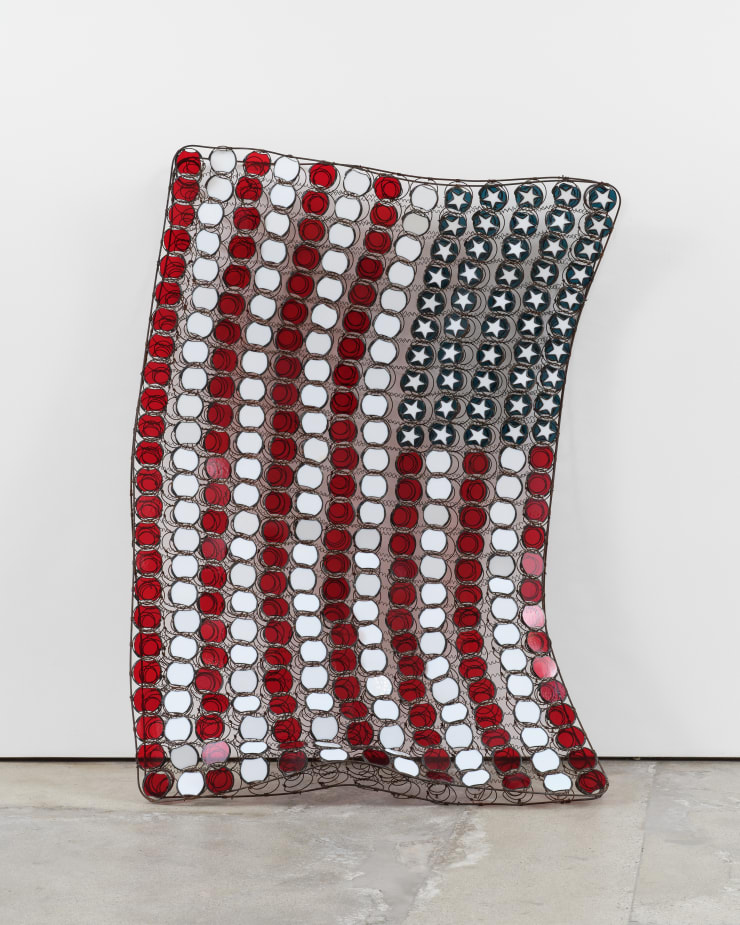timo fahler "TERMINAL CLASSIC": New York
Sebastian Gladstone is proud to present timo fahler's TERMINAL CLASSIC at our New York gallery. This exhibition gathers a new body of work made between Los Angeles and Amsterdam, during a time of personal upheaval and collective uncertainty. Fahler transforms found objects into images of history and myth, using everyday material to reveal the weight of ancestry, memory, and personal struggle.
The exhibition begins with a discarded mattress bedspring found in Los Angeles in 2024. fahler came across it while running, an integral part of his studio practice. For months it leaned on a studio wall until one day it revealed itself as a flag. The thirteen rows of springs became rows of red and white stripes. That act of recognition became the first gesture in this body of work, built from what was discarded and found around Los Angeles. flag was the last piece fahler made in the U.S., a quiet artifact that marks the end of an era for him.
From there, the materials began to guide him toward imagery that contrasts the ancient with the contemporary. The White House appears as a façade, like a stage prop or an empty shell, holding only the idea of something. The Mayan bee god Ah Muzen Cab shows up in glass with coin eyes and earpieces, a meditation on ecological loss, its link to economic fragility, and early notions of capital and class hierarchy. The Skybearer and Earthbearer, drawn from the tomb of Pakal, seem to hold a world that’s slipping apart. Smaller images pulled from Mayan codices—skulls, serpents, fragments of glyphs—echo the endless cycle of creation and destruction that belongs to both myth and the present.
Behind these works is the story of leaving Los Angeles and the United States. Fahler speaks to rising costs, broken politics, and the fear of raising children in a place that no longer felt safe. Moving to Amsterdam brought heartbreak but also clarity, and with it a renewed urgency to make work. The exhibition holds all of these contradictions: grief for a home that’s no longer home and the excitement of the new, the feeling of never being brown enough as a Mexican or white enough as an American, the challenge of being a father while still being an artist.
The exhibition unfolds across two floors. Upstairs, the viewer encounters the world of the Mayan gods: the bearers, the altars, the symbols of empire and myth leading to the fallen Flag. Downstairs the eagle, the White House, and the yin-yang sit in close quarters. The upstairs speaks of mythical grandeur and eventual collapse, while the downstairs confronts the viewer with the immediacy of the present. Together they form a single narrative, a mirror of the duality that defines being human. Either in today’s fractured society, or through histories of the fallen past, how else can the nuance of humanity be understood except through the paradox of contradictory sentiments, allegiances, and collective failures and victories?
Fahler’s art isn’t an argument. It’s a record of what he sees and feels, shaped by the materials that define his world. Fences, gates, and beds all hold us in different ways—on our land, in our homes, in our sleep. He holds a piece of himself in each one, small glimpses into his inner landscape. The glass reflects and reveals at once, letting the light in while showing the present back to itself. The good, the bad, and everything in between.
-
 Timo Fahler, AH MUZEN CAB (the diving Bee god), 2025
Timo Fahler, AH MUZEN CAB (the diving Bee god), 2025 -
 Timo Fahler, SKYBEARER, 2025
Timo Fahler, SKYBEARER, 2025 -
 Timo Fahler, EARTHBEARER, 2025
Timo Fahler, EARTHBEARER, 2025 -
 Timo Fahler, flag, 2025
Timo Fahler, flag, 2025 -
 Timo Fahler, It's always been this way, 2025
Timo Fahler, It's always been this way, 2025 -
 Timo Fahler, BEWARE OF DOG (it’s just not that simple anymore), 2025
Timo Fahler, BEWARE OF DOG (it’s just not that simple anymore), 2025 -
 Timo Fahler, Idyllic, Idealic, Idea lick, i’d eel lick, i deal ick , 2025
Timo Fahler, Idyllic, Idealic, Idea lick, i’d eel lick, i deal ick , 2025 -
 Timo Fahler, topos haliaeetus , 2022-23
Timo Fahler, topos haliaeetus , 2022-23




















